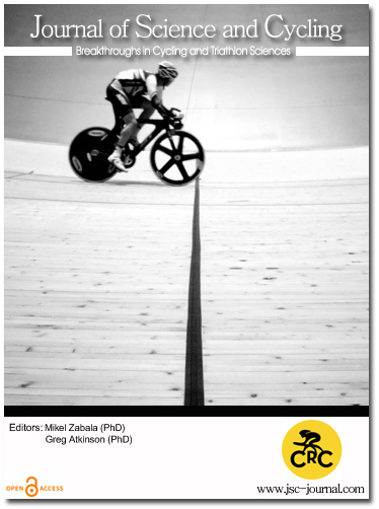Power output and affective load change during time trial according to environmental conditions
Abstract
Introduction: During cycling events, riders have to face to different environmental conditions like wind or road gradient, which leads to variable resistive forces. Those resistances involve a specific pedaling cadence (PC) – crank inertial load (CIL) association and modify the level of power output (PO) (Hansen et al., 2002). The different environmental conditions also could influence the affective load (AL), defined like the difference between perception of exertion rate and pleasure (Baron et al., 2011). The purpose of this study was to analyze the influence of different environmental conditions on PO and AL.Method: Eight amateur competitive cyclists performed five 25 ± 5min TT sessions at their maximal capacity in different environmental conditions: 1) in level ground with 3 different wind conditions: no wind (NW), headwind (HW), tailwind (TW). The wind velocity was 40 ± 5 km/h, 2) in uphill (UP) with a mean slope of 8% and 3) on Home Trainer (HT). PO was recorded from a Power Tap® power meter. Every 4 minutes, riders had to rate their exercise perceived exertion from a CR10 Borg scale and their pleasure on a “pleasure scale” to evaluate their AL. An ANOVA statistical test was used to analyze the evolution of PO and AL over the time between the different conditions.
Results: PO is significantly different between all conditions and varies over the time. Different pacing strategies are observed with a fast start and a final spurt. PO is higher in NW and TW (+ 3.5%) compared with HW and UP. There are correlations between PC and cycling speed (v) (r = 0.84, p<0.001) and between CIL and v (r = 0.92, p<0.001). AL increases over the time (p<0.05) for all the conditions and is significantly different between all conditions (p<0.05). AL is higher (+56%) in HW compared with the others conditions.
Discussion / Conclusion: PO varies significantly according to wind and road gradient conditions. For each condition, riders select a specific PC – CIL combination which modifies PO and AL. The higher AL observed in HW was not associated with the higher PO. The changes in the PC – CIL combinations determined different whole body sensations that could play a role on AL. The changes in resistive forces involve different crank torque profiles which modify the force-length relationship, the muscular contraction velocity and muscular strains. So, to decrease AL it seems necessary to adopt an optimal gear according to the field and learn to tame the environmental conditions. This requires specific and regular training.
Downloads
Published
How to Cite
Issue
Section
Copyright (c) 2014 Journal of Science and Cycling

This work is licensed under a Creative Commons Attribution-NonCommercial 4.0 International License.
Authors contributing to Journal of Science and Cycling agree to publish their articles under a Creative Commons CC BY-NC-ND license, allowing third parties to copy and redistribute the material in any medium or format, and to remix, transform, and build upon the material, for any purpose, even commercially, under the condition that appropriate credit is given, that a link to the license is provided, and that you indicate if changes were made. You may do so in any reasonable manner, but not in any way that suggests the licensor endorses you or your use.
Authors retain copyright of their work, with first publication rights granted to Cycling Research Center.






